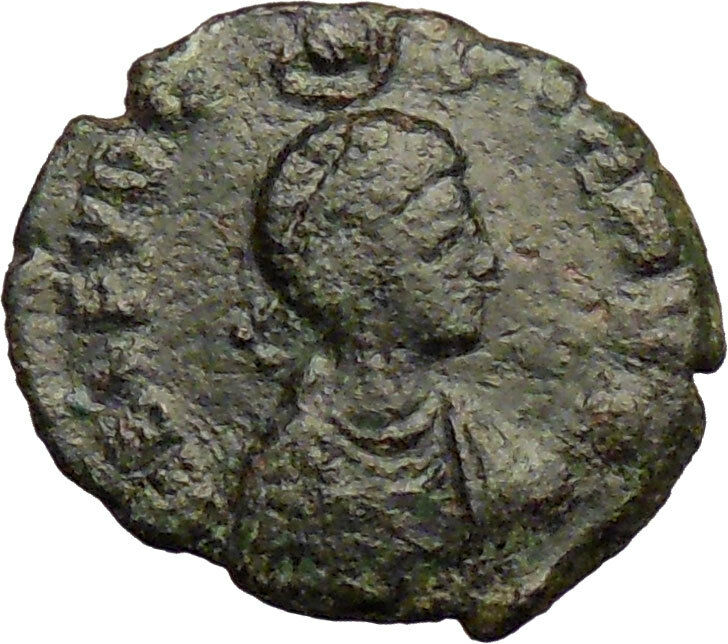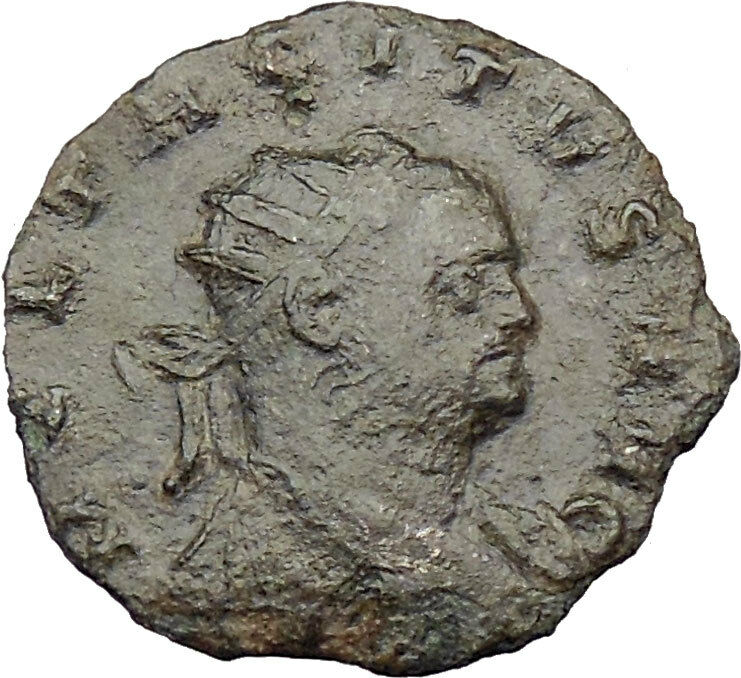|
Claudius II – Roman Emperor: 268-270 A.D.
Bronze Antoninianus 18mm (2.58 grams) Struck at the mint of Rome 268-270
A.D.
Reference: RIC 38k(var.)
IMPCLAVDIVSAVG – Radiate head right.
FIDESMILITVM – Fides standing left, holding vexillum and scepter; Є in right
field.
You are bidding on the exact item pictured,
provided with a Certificate of Authenticity and Lifetime Guarantee of
Authenticity.
In
Roman mythology
, Fides (“trust”) was the goddess of
trust
. Her Greek
equivalent was
Pistis
. Her temple on the
Capitol was where
the Roman Senate
kept state treaties with foreign countries, where Fides
protected them. She was also worshipped under the name Fides Publica Populi
Romani (“trust towards the Roman state”). She is represented by a young
woman crowned with an olive branch, with a cup or
turtle
, or a
military ensign in hand. She wears a white veil or stola; her priests wear
white.
Rome’s second king,
Numa Pompilius
instituted a yearly festival to Fides, and directed the priests to be borne to
Her temple in an arched chariot drawn by two horses and should conduct Her
services with their hands wrapped up to indicate protection.
The vexillum (English pronunciation:
plural vexilla was
a flag
-like object used in the
Classical Era
of the
Roman Empire
. The word is itself a diminutive
for the Latin word, velum, sail, which confirms the historical evidence (from
coins and sculpture) that vexilla were literally “little sails” i.e. flag-like
standards. In the vexillum the cloth was draped from a horizontal crossbar
suspended from the staff; this is unlike most modern flags in which the ‘hoist’
of the cloth is attached directly to the vertical staff. The bearer of a
vexillum was known as a
vexillarius
or vexillifer. Just as
in the case of the regimental colors or flag of Western regiments, the vexillum
was a treasured symbol of the military unit that it represented and it was
closely defended in combat
.
Nearly all of the present-day regions of
Italy
preserve the use of vexilla. Many
Christian processional banners are in the vexillum form; usually these banners
are termed labara
(Greek:
λάβαρον) after the standard adopted by the
first Christian Roman emperor
Constantine I
which replaced the imperial eagle
with the “Chi-Rho”
symbol
☧
.
The term Vexillum is also used by the
Legion of Mary
as the term for its standard. A
small version is used on the altar and a full size Vexillum leads processions.
Marcus Aurelius Claudius (May
10, 213
– January, 270), often referred to as Claudius Gothicus or Claudius II,
was a Roman Emperor
. He ruled the
Roman
Empire
for less than two years (268 – 270), but during that brief time he
managed to obtain some successes. He was later given divine status.
//
Life
Origin
and rise to power
Claudius’ origin is uncertain. He was either from
Sirmium
(Syrmia;
in Pannonia
Inferior) or from Naissus
Dardania
(in
Moesia Superior
); both areas are located in
Serbia
.
Claudius was the commander of the Roman army that decisively defeated the
Goths
at the
Battle of Naissus
in September 268; in the same month, he attained the
throne, amid charges, never proven, that he murdered his predecessor
Gallienus
.
However, he soon proved to be less than bloodthirsty, as he asked the
Roman
Senate
to spare the lives of Gallienus’ family and supporters. He was less
magnanimous toward Rome’s enemies, however, and it was to this that he owed his
popularity.
Claudius, like
Maximinus Thrax
before him, was of barbarian birth. After an interlude of
failed aristocratic Roman emperors since Maximinus’s death, Claudius was the
first in a series of tough soldier-emperors who would eventually restore the
Empire from the
Crisis of the third century
.
Claudius
as emperor
At the time of his accession, the Roman Empire was in serious danger from
several incursions, both within and outside its borders. The most pressing of
these was an invasion of Illyricum and
Pannonia
by
the Goths
. Not
long after being named emperor (or just prior to Gallienus’ death, depending on
the source), he won his greatest victory, and one of the greatest in the history
of Roman arms.

The Roman Empire in 268 A.D
At the
Battle of Naissus
, Claudius and his legions routed a huge Gothic army.
Together with his cavalry commander, the future Emperor
Aurelian
,
the Romans took thousands of prisoners, destroyed the Gothic cavalry as a force
and stormed their laager (a circular alignment of wagons long favored by the
Goths). The victory earned Claudius his surname of “Gothicus” (conqueror of the
Goths), and that is how he is known to this day. More importantly, the Goths
were soon driven back across the
Danube River
, and a century passed before they again posed a serious threat
to the empire.
While this was going on, the Germanic tribe known as the
Alamanni
had crossed the Alps
and attacked the empire. Claudius responded quickly, routing the Alamanni at the
Battle of Lake Benacus
in the late fall of 268, a few months after the
battle of Naissus. He then turned on the
Gallic Empire
, ruled by a pretender for the past fifteen years and
encompassing
Britain
, Gaul
,
and the
Iberian Peninsula
. He won several victories and soon regained control of
Spain and the Rhone river valley of Gaul. This set the stage for the ultimate
destruction of the Gallic Empire under Aurelian.
However, Claudius did not live long enough to fulfill his goal of reuniting
all the lost territories of the empire. Late in 269 he was preparing to go to
war against the Vandals
, who were raiding in
Pannonia
.
However, he fell victim to the
Plague of Cyprian
(possibly
smallpox
),
and died early in January 270. Before his death, he is thought to have named
Aurelian as his successor, although Claudius’ brother
Quintillus
briefly seized power.
The Senate
immediately deified Claudius as “Divus Claudius Gothicus”.
Links
to
Constantinian dynasty
The
Historia Augusta
reports Claudius and Quintillus having another brother
named Crispus and through him a niece. Said niece Claudia reportedly married
Eutropius and was mother to
Constantius Chlorus
. Historians however suspect this account to be a
genealogical
fabrication intended to link
Constantine I
‘s family to that of a well-respected emperor.
|









